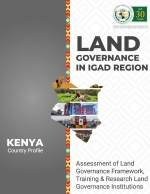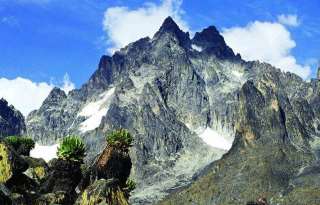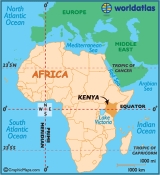|
|
|
Kenya is the economic, financial, and transport hub of East Africa. Agriculture remains the backbone of the Kenyan economy, contributing one-third of GDP. Tourism also holds a significant place in Kenya’s economy. In spite of political turmoil throughout the second half of 2017, tourism was up 20%, showcasing the strength of this sector. Now in his second term, current president Uhuru Kenyatta has pledged to make economic growth and development a centerpiece of his second administration, focusing on his “Big Four” initiatives of universal healthcare, food security, affordable housing, and expansion of manufacturing.
Profiles
 The Republic of Kenya is located in the eastern part of the African continent lying between latitudes 5° North and 5° South and between longitudes 34° West and 42° East. It is almost bisected by the equator and shares borders with Ethiopia and South Sudan to the North; Uganda to the West; Tanzania to the South; Somalia to the North East; and the Indian Ocean, the natural boundary to the South Eastern side, with a coastline of about 536 kilometres.
The Republic of Kenya is located in the eastern part of the African continent lying between latitudes 5° North and 5° South and between longitudes 34° West and 42° East. It is almost bisected by the equator and shares borders with Ethiopia and South Sudan to the North; Uganda to the West; Tanzania to the South; Somalia to the North East; and the Indian Ocean, the natural boundary to the South Eastern side, with a coastline of about 536 kilometres.
Kenya has an area of approximately 582,646 (sq. km) comprising 97.8% land and 2.2% water surface. Only 20% of the land area can be classified as medium to high potential (suitable for arable agricultural) and the rest of the land is mainly arid or semi-arid (suitable for extensive livestock production, wildlife and irrigated farming). Agricultural land makes up 48% of the land area. According to the Kenya National Bureau of Statistics there are 43 million people in Kenya as of 2015. 78% of the population is rural.
Read More on folder Profiles...
Gender and Land
Land plays a critical role as a source of livelihood for billions of people around the world. Thus, land distribution, access, management and use are crucial to the form that economic development takes and, in the early stages of development, many countries have undertaken land reforms in order to boost economic development through the transfer of the concentration of wealth from the hands of a few wealthy land-owners to a land-deprived majority. In yester years, the governments of South Korea, Taiwan and Japan undertook successful land reforms which have been much echoed as devices of poverty and landlessness alleviation, assisting industrialization by shifting privately held land to tenant farmers without breaking up productive holdings through land consolidation.
Read More on folder Gender...
Land and Conflict
This article contributes to the field of natural resource conflict management by investigating the holistic context of a conflict case and argues against a simple resource scarcity conflict thesis. The article takes point of departure in a pragmatic world view of conflicts in Laikipia County, Kenya, through a likert-type questionnaire survey (N ¼ 352), semi-structured interviews, extensive field notes and participant observation. Using an adapted version of the Unifying Negotiation Framework (UNF) to conduct an in-depth context analysis, the article shows the multitude of ecological, social and institutional factors which impact on the conflict complex. The critical features of the conflict from the perspective of pastoralists and farmers in Laikipia were found to be related to trust, communication, security, governance, marginalisation and violence. By conducting a thorough conflict context analysis incorporating social, ecological and institutional elements, valuable insights can be gleaned, leading to a more holistic conflict management approach.
Read More on folder Conflict...
Land and Investment
The East African Community (EAC) suffers from a critical lack of cross-border railway networks that, if remedied, could improve regional connectivity and boost intra regional trade. The region would also become more investor-friendly. Cross-border railway connectivity is particularly important owing to the challenging geographical location and small, uncompetitive and inefficient Partner States.
Read More on folder Investment...
Land and Rural Development
Sub-Saharan Africa (SSA) is about the only region in the world where many development indicators are declining or stagnant. It continues to exhibit weak growth in productive sectors; poor export performance; mounting internal and external debts; deteriorating social conditions; environmental degradation; crisis of confidence; institutional decay and political instability.
Read More on folder Rural Development...
Land and Urbanization
In this brief, a review of the Kenyan housing market across 5 dimensions is conducted. These are: (i) demand and supply gap, (ii) access to finance, (iii) building technologies and related costs, (iv) real estate developers capacity, and (v) land, property and land off-site trunk infrastructure. The analysis conducted draws out the key impedimentsexplaining housing dynamics and provides a backdrop against which private sector participation in the sector can be framed.
Read More on folder Urbanization...
Land Laws and Policies
We, the people of Kenya -
ACKNOWLEDGING the supremacy of the Almighty God of all creation:
HONOURING those who heroically struggled to bring freedom and justice to our land:
PROUD of our ethnic, cultural and religious diversity, and determined to live in peace and unity as one indivisible sovereign nation:
RESPECTFUL of the environment, which is our heritage, and determined to sustain it for the benefit of future generations:
COMMITTED to nurturing and protecting the well-being of the individual, the family, communities and the nation:
RECOGNISING the aspirations of all Kenyans for a government based on the essential values of human rights, equality, freedom, democracy, social justice and the rule of law:
EXERCISING our sovereign and inalienable right to determine the form of governance of our country and having participated fully in the making of this Constitution:
ADOPT, ENACT and give this Constitution to ourselves and to our future generations.
Read More on folder Legislation and Policies...

